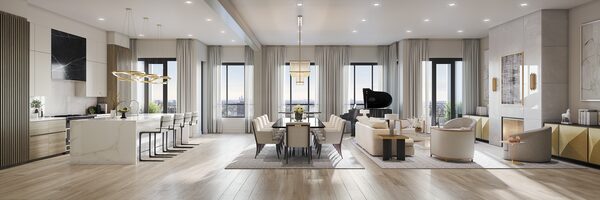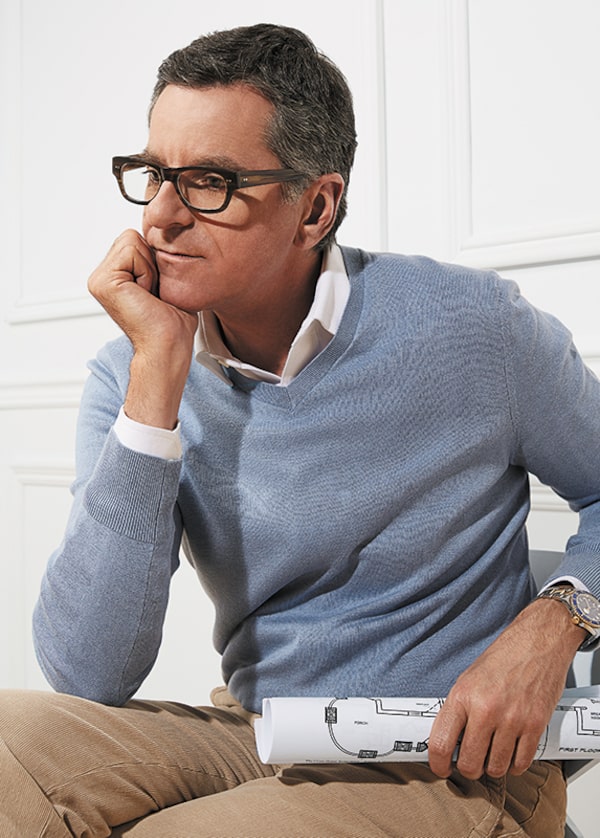
The light wood floors in taupes and blondes, featured in the units of 89 Avenue Yorkville, are current interior decor trends, says interior designer Brian Gluckstein.A Plus Creative
Light and airy interiors top designer Brian Gluckstein’s list for health-conscious homeowners
Bastions of health and wellness. That’s how Brian Gluckstein’s clients began to think of their homes during two years of pandemic restrictions. But even as health and travel rules have eased, that mindset hasn’t changed, says the renowned interior designer and owner of Toronto-based Gluckstein Design Planning Inc. whose latest project is 89 Avenue Yorkville, a luxury residential building by Armour Heights Developments. Gluckstein says his clients, many of whom own several properties – a vacation home south of the border, as well as a cottage up north and a home in the city – want lavish spaces with access to light, fresh air and amenities that enhance their well-being. We asked him how those desires are being expressed in the designs of today.

Interior designer Brian Gluckstein: “People want more light.”Gluckstein Design PLANNING Inc.
As we head into summer, what are some of the home design trends you’re seeing?
Clients are spending more and more time outside, and we’re doing a lot of outdoor kitchens, where people are really living out there. They’re dining, cooking, entertaining outside. So whether it’s a back garden or a balcony or terrace or penthouse, we’re seeing a big focus on outdoor space and outdoor living. The outdoor kitchen is a big thing: pizza ovens and barbecues. For some people, it’s an alternative to a cottage. People have been cooped up so much during the winter and they just want to get outside.
What about interiors?
The trend [is] light wood floors in taupes and blondes; Belgian floors and northern European floors. With those dark winters, people want more light. [There’s also] a lot of focus on real plants and trees inside the house. It really softens the space. I’ve always had that in my house, a huge tree in the foyer, and when I’m Zooming or when people come over, they always comment on it. So, I always have plants and fresh flowers in the house. A home is more alive when it has plants in it. The bigger, the better.
Is health and wellness still a big factor?
COVID really pushed that. People weren’t going to the gym, and they were getting used to working from home, and now we’re seeing them thinking that I might go to the gym once in a while, but I want to create that space at home. So, it’s not just the gym, it’s all about wellness – saunas, steam rooms, massage areas, exercise equipment or free weights, equipment like the Pelotons, where you can engage with other people.
What about colours and fabrics? How do they lend themselves to creating a sense of relaxation and wellness?
Because people have been working at home and are continuing in some capacity to work at home, they want spaces that are quite bright. If you work [outside the home] every day, and you come home and you have this very dark space or dramatic dark dining room or den, it’s impactful. But when people are working from home, they want airy and bright. So, we’re seeing a trend towards light when it comes to paints, upholstery, wood, cabinetry, things like that.
Tell us about 89 Avenue Yorkville, which you’ve been involved in designing.
The quality of the building is amazing. The level of detail in the public spaces and the suites is really quite unbelievable. We’re putting so much detail into the lobby and then all the common areas in the building. We’re pushing the envelope as far as the quality of the finishes, the design details, whether it’s suite entrances, lobbies, the pool, the car drop-off area – it’s all extremely luxurious, probably one of the most luxurious buildings in Toronto.
Are clients more sophisticated now about interior design?
Absolutely. I think the combination of shelter magazines and then the evolution to social media, whether it’s FaceTime or Pinterest, they’re seeing a very high level of design on those platforms. And they’re travelling, visiting friends, and they’re going to great hotels. The level of design is quite different in hotels today, compared to 20 or 30 years ago. A luxury hotel today is very design-oriented, whereas a decade ago or a couple of decades ago, there was sort of a generic look with certain hotel chains. They all looked the same. And now design has changed, where the hotels and restaurants are really high-design spaces, and that design is based on the environment they are in, whether they’re at a resort on a beach or in an urban centre. [People] are exposed to incredible design spaces, in the boutique hotels especially. And they’re bringing that back with them. Same thing with retail design – we have clients who say we want our dressing room in our house to look like the Dior store in Paris. We’ve had that, where they bring back pictures of the fixtures, and the lighting and the furniture from very luxurious stores.
This interview has been edited and condensed.
Advertising feature produced by Globe Content Studio. The Globe’s editorial department was not involved.